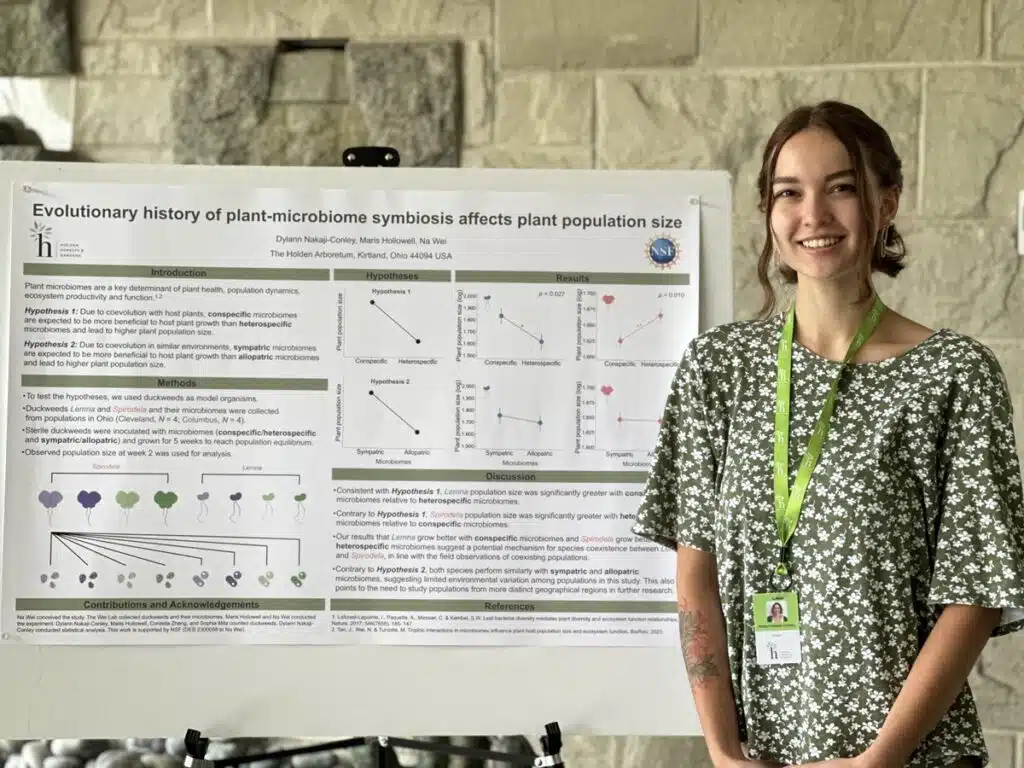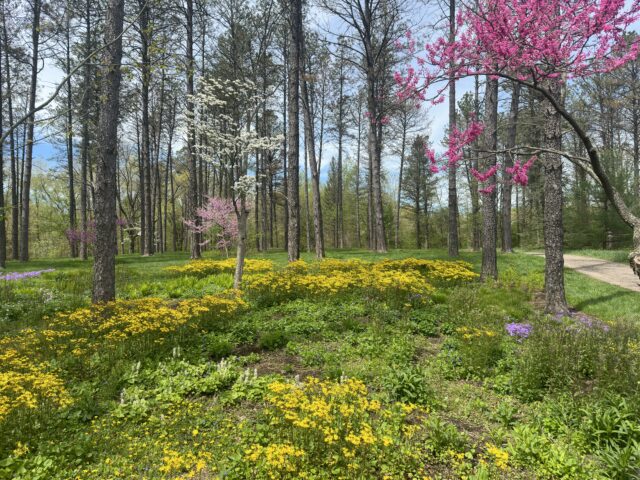Tiny Plant, Big Solutions: Duckweed’s Contentious Reputation and Scientific History
November 10, 2023

You’ve likely come by a pond, lake, or even a drainage ditch, and noticed a layer of green on the water. It can look solid enough to almost be mistaken for land, unless a disturbance by a duck or frog has sent ripples of dark swirls across the surface. Look closely, and you’ll see it’s not a sticky froth of algae, either, but a colony of very small plants, each one about half the size of your pinky nail. It’s the smallest flowering plant in the world, and it can likely be found in your neighborhood: duckweed.
When I first began a summer internship at Holden Arboretum’s Long Science Center, I was mostly unaware of the plant. Other than as food for my roommate’s goldfish, I thought of duckweed as most seem to: as a pest. But this summer, duckweed was the focus of our research. Or rather, duckweed is the model organism that Dr. Na Wei’s lab uses to study a type of plant-microbiome interactions called symbiosis.
But why duckweed? Isn’t it invasive? When I presented my research poster at the end of the summer, I got the same questions. But in the past few months, I’ve learned that duckweed deserves a better reputation. It’s a plant that has contributed to science for decades and presents a wide array of practical applications for some of society’s most pressing concerns, like climate change and environmental restoration.

What is Duckweed?
Duckweed, also known as water lentils or water meal, is a common name for a family of ancient plants called the Lemnaceae. Like other plants with “weed” in the name, duckweed is prolific and resilient. This rapid-growing plant is found in ecosystems on every continent except Antarctica. With the right light and nutrient levels, duckweed can withstand a wide range of pH levels and temperatures, and under optimal conditions, it can double its mass in 2-4 days. In the Wei lab, as I stared at test tubes full of fronds, I found that a thin floating layer of duckweed of the genus Lemna could contain anywhere from 50 to over 100 individual plants.
Unlike most plants, duckweeds substitute leaves and stems for fronds that float atop the water’s surface. They possess hairlike roots and, on rare occasions, flowers. Though most of the time duckweeds reproduce clonally, flowering occurs as a response to stress, allowing the plant to form resilient seeds that lay waiting for more favorable conditions. Some don’t have roots at all, and some form bud-like structures that lay dormant over winter. The plant is simple and inconspicuous, a nutrient-rich food for their namesake waterfowl and a tiny home to small organisms.
Duckweed: A Model Organism
This long list of adaptations is behind the plant’s long history of scientific study. Its tiny size, few anatomical features, fast growth, resilience, and pervasiveness make it an ideal system for testing environmental factors and stress.
In fact, duckweed has been a model system for plant biology since the 1950s. It helped researchers understand basic functions of proteins and nucleic acids and provided insights into photosynthesis, nutrient turnover, and other key processes in plants. Its clonal reproduction and, for some species, small genome size also made it a model plant for genetic research starting in the 1970s. But its scientific record goes back even further: The first published record of a study on Lemnaceae is an 1839 monograph by botanist Matthias J. Schleiden, one of the originators of cell theory.
Due to advancements in genetic tools in the past decade, duckweed has again come to the spotlight in academic research. Current studies recognize duckweed for its resilience, exploring its aptitude for carbon dioxide uptake and water remediation.
The Power of Duckweed
Though small, this family of aquatic plants is adept at bioremediation, that is, taking up environmental pollutants. Duckweed — and the microbes that live on it — can absorb nitrogen and phosphate from agricultural and other runoff, and use them for plant growth. Lemnaceae can also withstand irradiation, uptake heavy metals from water, and intake carbon dioxide from the atmosphere. For pollutants that can be accumulated but not broken down by the plant, such as industrial dyes and heavy metals, allowing duckweed to grow and then skimming it out of the water takes the contamination with it.
Various aquatic plants have been used for the bioremediation of wastewater, but duckweed stands out. Their high growth rate, ability to be recycled in multiple ways, simple maintenance, and easy harvesting make it a top subject of current research. The USDA, EPA, and U.S. Geological Survey are currently exploring duckweed’s role as an alternative remedy for waste and detoxification of water ecosystems.
Once collected, uncontaminated duckweed also has the potential to be fuel for our homes and our stomachs. Dry it out, compact it into a pellet, and you have a biofuel that can be burned or further converted into renewable biogas, ethanol, or gasoline. Studies propose a closed-loop production process in which duckweed removes carbon dioxide from the ambient atmosphere, is burned for fuel, and the ash is returned to the water as fertilizer for further duckweed growth. The low cost of production and maintenance means duckweed-sourced biofuel may become very cost-competitive with existing oil refineries.
Though I didn’t get to taste any duckweed during my field collection trips at the Holden Arboretum — and I wouldn’t recommend it — duckweed has potential as animal feed and even human food due to its high protein, nutrient, and starch content. The plant contains all the essential amino acids for humans. Depending on the strain of duckweed, your diet could be supplemented with different levels of fats, minerals, carotenoids, sterols, and uniquely high levels of the essential human micronutrient zeaxanthin.
Duckweed could be next on the plate for astronauts too. Its ability to recycle wastewater, remove carbon dioxide from the cabin air, provide oxygen, and produce edible biomass, all in a small area, make this organism a prime candidate for space exploration.
Too much of a good thing?
So why does duckweed have a bad reputation? It is more about aesthetics, since duckweed, under certain conditions, can quickly colonize bodies of water.
The USDA Forest Service defines invasive plants as both “non-native to the ecosystem” and “whose introduction causes or is likely to cause economic or environmental harm or harm to human health”. Most duckweed species found in North America are native, but some of them do have the ability to take over still and slow-moving waters. This has earned them a reputation for “invasive behavior,” even if they don’t technically meet the criteria.
Expanding the research
As we expand our understanding of how this small plant contributes to the environment, two other factors contribute to the complexity of duckweed research: clonal reproduction and microbial diversity.
Newly sprouted fronds are clones, meaning they have the same genetic makeup as the mother frond. You would then expect a universal appearance among duckweed of the same species, but that’s not the case. I observed this firsthand, noticing variations in color and size in samples of duckweed Spirodela polyrhiza, from different locations in the U.S. This is caused by local adaptation of different populations to their own environments. In fact, research has shown that clones of the same species show considerable variation in growth potential, salt tolerance, acclimation to nutrient deficiency, resistance to microbial attack, and growth in agricultural waste.
Similarly, duckweed populations from different geographic regions possess different microbial communities, as a recent paper from the Wei Lab pointed out. Depending on its composition, this community can enhance the growth, nutrient and heavy metal uptake, stress tolerance, and pathogen resistance of the host plant. Conversely, some microorganisms are parasitic and may compete with plants for nutrients. The same bacterial strain may even promote duckweed growth under some conditions and reduce plant growth in others.
With accumulating and emerging evidence indicating the importance of microbial communities to plant health and function, Dr. Wei’s research exploring plant-microbiome symbiosis enhances our understanding of how plants and ecosystems may respond to environmental change, Particularly, how will microbiomes affect plants and ecosystems under climate change? Will duckweed’s clonality and microbial differences make certain populations more adaptive than others? With duckweed and its microbial communities poised to be important contributors to habitat restoration, fossil fuel alternatives, and dietary supplements, it is worthwhile to expand our understanding of this small but powerful plant.
Next time you go on a stroll at the Holden Arboretum – or wherever you are — look in the ponds for this tiny-but-mighty plant and remember that it’s having complex impacts on its waters and our ecosystems. We’re happy to have it in our ponds, cleaning up the water and air.
Dylann Nakaji-Conley
Research Intern













